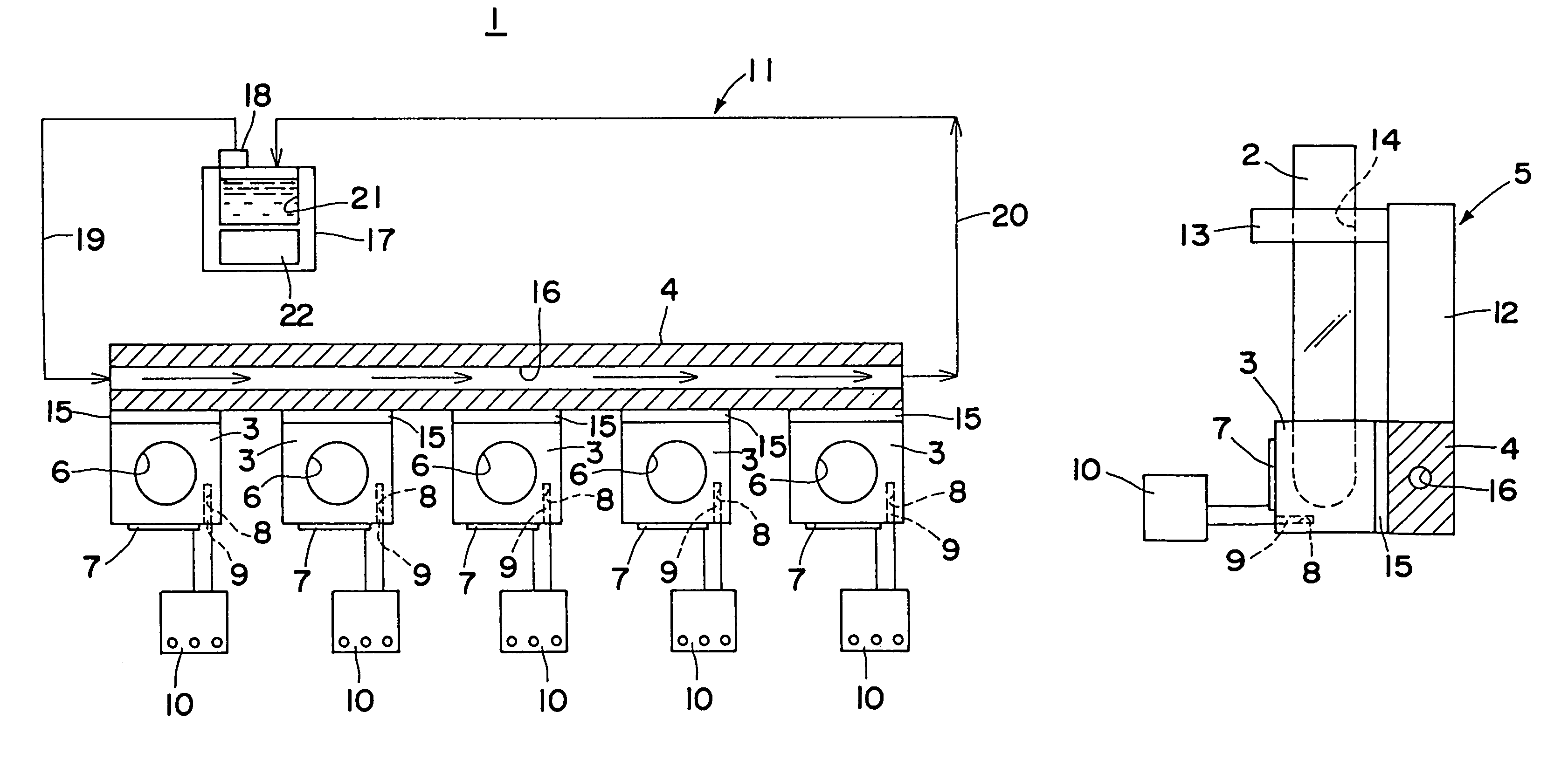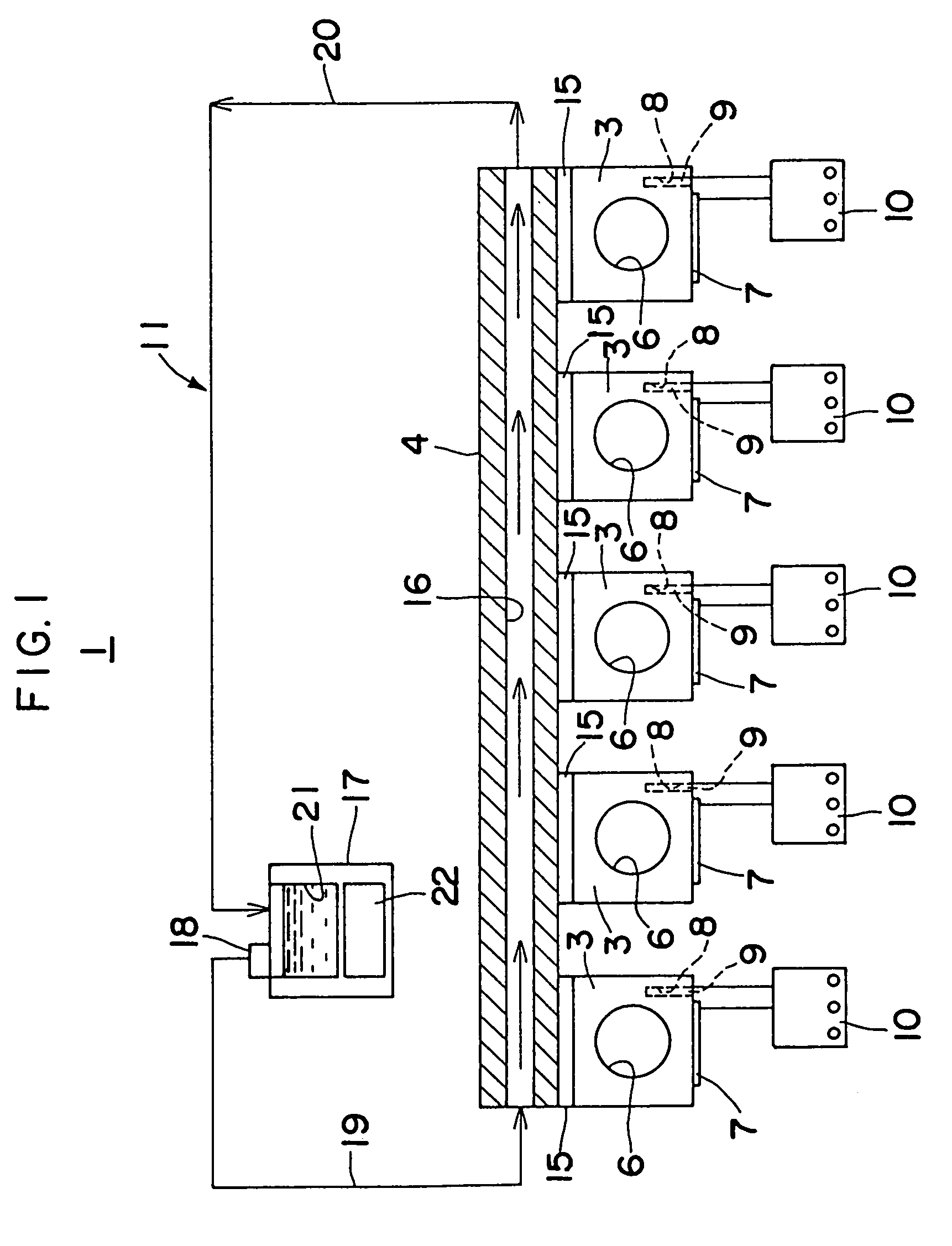Sample temperature regulator
a temperature regulator and sample technology, applied in the field of sample temperature regulators, can solve the problems of reducing the heating rate of aluminum blocks, affecting the performance of the device, so as to achieve the effect of simple structure, durable and inexpensive, and resistance to impacts and vibrations
- Summary
- Abstract
- Description
- Claims
- Application Information
AI Technical Summary
Benefits of technology
Problems solved by technology
Method used
Image
Examples
first embodiment
[0036]The cooling mechanism 11 in the temperature regulator 1 shown in FIGS. 1 to 3 has a circulating passage containing a refrigerant channel 16 defined longitudinally through the cooling block 4; an antifreeze cooling unit 17; a pipe 19 connecting the antifreeze cooling unit 17 to an inlet of the refrigerant channel 16 through a circulating pump 18; and a pipe 20 connecting an outlet of the refrigerant channel 16 to the antifreeze cooling unit 17. The cooling block 4 is cooled during the process that the antifreezing fluid supplied as a low-temperature refrigerant from the antifreeze cooling unit 17 flows from the inlet to the outlet of the refrigerant channel 16. Here, as the antifreeze cooling unit 17, for example, one having an antifreeze tank 21 and a cooler 22 disposed under the tank 21, as shown in FIG. 1, can be used.
second embodiment
[0037]The cooling mechanism 11 of the temperature regulator 1 shown in FIG. 4 has a circulating passage containing a metal pipe 32 with a closed end fitted in a through hole 31 defined longitudinally through the cooling block 4; a refrigerant injecting pipe 33 inserted to the metal pipe 32 through its opening to the closed end of the pipe 32; a vapor refrigerant cooling unit 34; a pipe 35 connecting the vapor refrigerant cooling unit 34 to the refrigerant injecting pipe 33; and a pipe 36 connecting the opening of the metal pipe 32 to the vapor refrigerant cooling unit 34. In the cooling block 4, the vapor refrigerant supplied from the vapor refrigerant cooling unit 34 and injected from the tip of the refrigerant injecting pipe 33 is cooled while it flows through the metal pipe 32 along the bottom to the opening thereof. As the vapor refrigerant cooling unit 34, there may be employed, for example, an immersion cooler provided with a cooling unit 37, as shown in FIG. 4.
third embodiment
[0038]The cooling mechanism 11 of the temperature regulator 1 shown in FIG. 5, contains a refrigerant channel 41 defined longitudinally through the cooling block 4; a low-temperature vapor refrigerant generator 42; a pipe 44 connecting a heating section 43 of the low-temperature vapor refrigerant generator 42 to an inlet of the refrigerant channel 41; and an exhaust pipe 45 connected to an outlet of the refrigerant channel 41. In the cooling block 4, the liquefied gas vaporized under heating in the heating section 43 is cooled while it flows from the inlet to the outlet of the refrigerant channel 41. Here, the liquefied gas serving as the low-temperature refrigerant is stored, for example, in a tank 46 in the low-temperature vapor refrigerant generator 42, as shown in FIG. 5.
PUM
 Login to View More
Login to View More Abstract
Description
Claims
Application Information
 Login to View More
Login to View More - R&D
- Intellectual Property
- Life Sciences
- Materials
- Tech Scout
- Unparalleled Data Quality
- Higher Quality Content
- 60% Fewer Hallucinations
Browse by: Latest US Patents, China's latest patents, Technical Efficacy Thesaurus, Application Domain, Technology Topic, Popular Technical Reports.
© 2025 PatSnap. All rights reserved.Legal|Privacy policy|Modern Slavery Act Transparency Statement|Sitemap|About US| Contact US: help@patsnap.com



